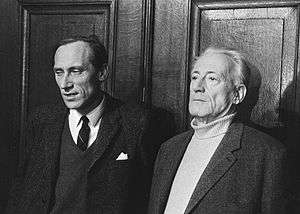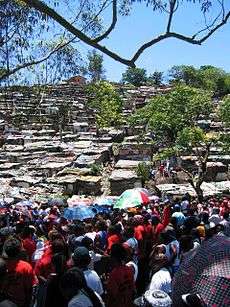Right to the city
The right to the city is an idea and a slogan that was first proposed by Henri Lefebvre in his 1968 book Le Droit à la ville [1][2] and that has been reclaimed more recently by social movements, thinkers and several progressive local authorities alike as a call to action to reclaim the city as a co-created space—a place for life detached from the growing effects that commodification and capitalism have had over social interaction and the rise of spatial inequalities in worldwide cities throughout the last two centuries.[3]


Overview

In his first inception of the concept, Lefebvre paid specific emphasis on the effects that capitalism had over “the city”, whereby urban life was downgraded into a commodity, social interaction became increasingly uprooted and urban space and governance were turned into exclusive goods.[4] In opposition to this trend, Lefevbre called to “rescue the citizen as main element and protagonist of the city that he himself had built” and to transform urban space into “a meeting point for building collective life”.[4]
Due to the inequalities produced by the rapid increase of world urban population in most regions of the world, the concept of the right to the city has been recalled on several occasions since the publication of Lefevbre’s book as a call to action by social movements and grassroots organizations. In their appeal for “their right to the city”, local mobilizations around the world usually refer to their struggle for social justice and dignified access to urban life to face growing urban inequalities (especially in large metropolitan concepts). The right to the city has had a particular influence in Latin America and Europe, where social movements have particularly appealed to the concept in their actions and promoted local instruments for advancing its concrete understanding in terms of policy-making at the local and even national level.[5][6] A good proof on how the notion of right to the city has gained international recognition in the last years could be seen in the United Nations Habitat III process, and how the New Urban Agenda (2016) recognized the concept as the vision of “cities for all”.[7]
Lefebvre summarizes the idea as a "demand...[for] a transformed and renewed access to urban life".[8][9] David Harvey described it as follows:
The right to the city is far more than the individual liberty to access urban resources: it is a right to change ourselves by changing the city. It is, moreover, a common rather than an individual right since this transformation inevitably depends upon the exercise of a collective power to reshape the processes of urbanization. The freedom to make and remake our cities and ourselves is, I want to argue, one of the most precious yet most neglected of our human rights.[10]
Recent popular movements


A number of popular movements, such as the shack dwellers' movement Abahlali baseMjondolo in South Africa,[11] the Right to the City Alliance in the United States,[12] Recht auf Stadt,[13] a network of squatters, tenants and artists in Hamburg, and various movements in Asia and Latin America,[14] have incorporated the idea of the right to the city into their struggles.
In Brazil the 2001 City Statute wrote the Right to the City into federal law.[15]
More recently, scholars have proposed a 'Digital Right to the City',[16][17] which involves thinking about the city as not just bricks and mortar, but also digital code and information.[18]
Women's right to the city
The urban form of cities is gendered, and feminist scholars have argued that the right to the city needs to be understood in gendered terms. For instance in São Paulo, one in every three women over the age of 16 has experienced some sort of sexual violence. In New Delhi, women are afraid of using the public transportation system because of the threat of rape.[19]
Criticism
The growing popularity of the concept has nonetheless raised some criticism and concerns on how the original vision of Henri Lefevbre could be reduced to a “citizenship vision”, focused on the mere implementation of social and economic rights in the city leaving aside its transformatory nature and the concept of social conflict behind the original concept.[20][21] Marcelo Lopes de Souza has for instance argued that as the right to the city has become "fashionable these days", "the price of this has often been the trivialisation and corruption of Lefebvre's concept"[22] and called for fidelity to the original radical meaning of the idea.
See also
References
- Purcell, Mark (October 2002). "Excavating Lefebvre: The right to the city and its urban politics of the inhabitant". GeoJournal. 58 (2–3): 99–108. CiteSeerX 10.1.1.357.4200. doi:10.1023/B:GEJO.0000010829.62237.8f. JSTOR 41147756.CS1 maint: ref=harv (link) Pdf.
- Unger, Knut (14 February 2009). ""Right to the City" as a response to the crisis: "Convergence" or divergence of urban social movements?". Reclaiming Spaces. Archived from the original on 10 March 2012.
- "David Harvey: The Right to the City. New Left Review 53, September-October 2008". newleftreview.org. Retrieved 2018-06-14.
- Swing, Capitán. "El derecho a la ciudad | Capitán Swing". capitanswing.com (in Spanish). Retrieved 2018-06-14.
- "Competitive Metropolises and the Prospects for Spatial Justice | CISDP". www.uclg-cisdp.org. Retrieved 2018-06-14.
- "What Is The Right to the City? | RioOnWatch". www.rioonwatch.org. Retrieved 2018-06-14.
- Colau, Ada (2016-10-20). "After Habitat III: a stronger urban future must be based on the right to the city". the Guardian. Retrieved 2018-06-14.
- Lefebvre, Henri (1996), "The right to the city", in Kofman, Eleonore; Lebas, Elizabeth (eds.), Writings on cities, Cambridge, Massachusetts: Wiley-Blackwell, p. 158, ISBN 9780631191889.CS1 maint: ref=harv (link)
- Attoh, Kafui (October 2011). "What kind of right is the right to the city?". Progress in Human Geography. 35 (5): 669–685. doi:10.1177/0309132510394706.CS1 maint: ref=harv (link)
- Harvey, David (September–October 2008). "The right to the city". New Left Review. II (53): 23–40.CS1 maint: ref=harv (link)
- Abahlali_3 (17 January 2013). "S'bu Zikode & Richard Pithouse debating Pallo Jordan on the Record of the ANC – Oslo, 22 November 2012". abahlali.org. Abahlali baseMjondolo. (Campaigns and Statements on The Right to the City.)
- Leavitt, Jackie; Roshan Samara, Tony; Brady, Marnie (Fall 2009). "The Right to the City Alliance: time to democratize urban governance (blog)". Progressive Planning, Planners Network. Archived from the original on 2010-04-29.
- Staff writer (2011). "Congress theses on The Right to the City". wiki.rechtaufstadt.net. Recht Auf Stadt.
- Mayer, Margit (2012), "The "right to the city" in urban social movements", in Brenner, Neil; Marcuse, Peter; Mayer, Margit (eds.), Cities for people not for profit: critical urban theory & the right to the city, New York: Routledge, pp. 63–85, ISBN 9780415601771.CS1 maint: ref=harv (link)
- Staff writer (14 October 2011). "Implementing the Right to the City in Brazil". sustainablecitiescollective.com. Sustainable Cities Collective.
- Joe Shaw and Mark Graham (15 February 2017). "Our Digital Rights to the City". meatspacepress.org. Meatspace Press.
- Foth, Marcus; Brynskov, Martin; Ojala, Timo (2015). Citizen's Right to the Digital City: Urban Interfaces, Activism, and Placemaking. Singapore: Springer. ISBN 9789812879172.
- Shaw, Joe; Graham, Mark (February 2017). "An Informational Right to the City? Code, Content, Control, and the Urbanization of Information". Antipode. 49 (4): 907–927. doi:10.1111/anti.12312.CS1 maint: ref=harv (link)
- "These Are the Most Dangerous Cities for Women". Global Citizen. Retrieved 2019-05-15.
- Delgado, Manuel (2018-03-19). "Elogio y rescate de Henri Lefebvre". El País (in Spanish). ISSN 1134-6582. Retrieved 2018-06-14.
- Gorgens, Tristan; van Donk, Mirjam (2011). "From basic needs towards socio-spatial transformation: coming to grips with the 'Right to the City' for the urban poor in South Africa". isandla.org.za. The Isandla Institute. Pdf.
- Lopes de Souza, Marcelo (May 2010). "Which right to which city? In defence of political-strategic clarity". Interface. 2 (1): 315–333.CS1 maint: ref=harv (link) Pdf. Archived 2012-01-19 at the Wayback Machine
Further reading
- Samara, Tony Roshan (June 2007). "Grassroots organizing: Right to the city". Z Magazine. 20 (6). Archived from the original on June 2007.CS1 maint: ref=harv (link)
External links
- World Charter for the Right to the City (PDF)z
- World Charter for the Right to the City (HTML)
- Proposal for a Charter for Women's Right to the City
- Proposals and Experiencies towards the Right to the City, Ana Sugranyes and Charlotte Mathivet (editors) 03-16-2010